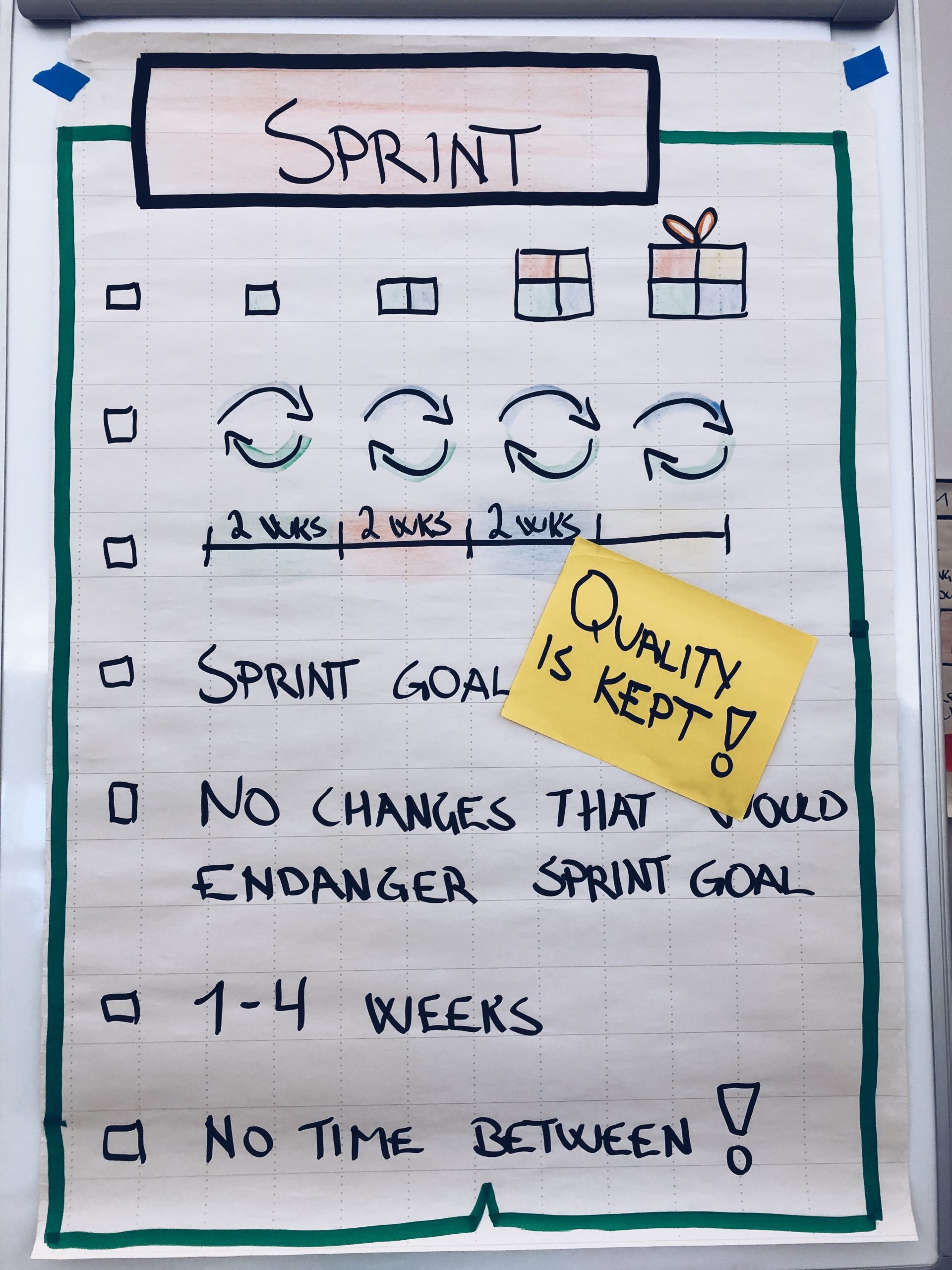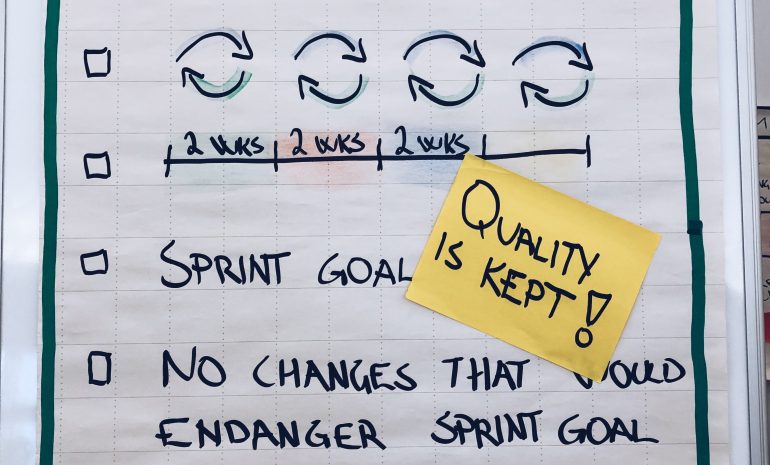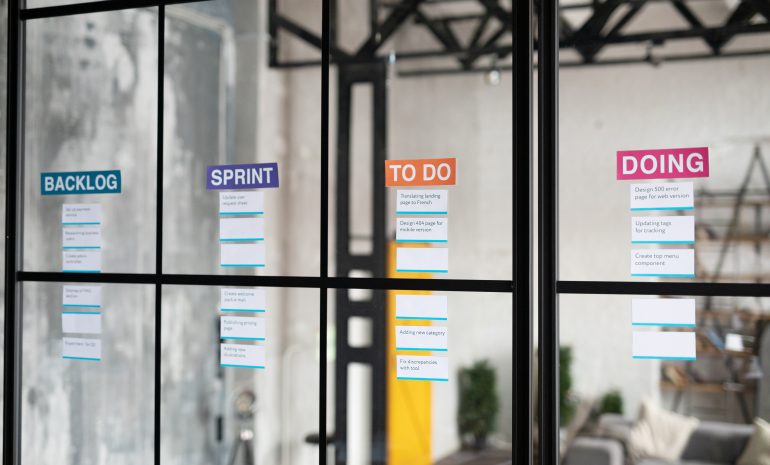In this article, we’ll tell you about three popular project management approaches and how we use them in Siesta. They’re called agile, waterfall and their combination called hybrid management. There’s a good chance you’ve already heard about them so if you’re unsure about some things, here’s a good opportunity to clarify them.
Agile management
Although it is a well-known framework, it is often paradoxically called agile methodology. Agile has gained popularity in recent years for its flexibility and we too manage almost 90% of our projects by implementing agile project framework. In English, agile stands for fast and active. And that’s how you can imagine it.
The main advantage of agile for you is that agile is client-centric. And it focuses on incorporating change instead of detailed planning.

It simplifies the long-term process into regularly recurring periods, usually 2 weeks. These are called sprints.
The essence of agile is the values that guide the project manager and the team through the entire project.
People and communication > Processes and tools
Working software > Complete documentation
Cooperation with client > Contract
Response to change > Proceed as planned
With short iterative development periods, where you give your feedback on working parts of the software, you’re running less risk of wasting your investment. This is because we can easily adapt the product to your newly occurred needs. You also have more room for experimentation this way.
That means for you:
- That you will actively give feedback on product development and the future direction of the product. So, in short, make the time. Agile development requires your work too.
- Together, we set the next steps of development, we test, and you provide feedback from users.
- And because in agile there is often no definite end to a project, development can run for years. Until you run out of ideas or resources. That’s up to you.
The Agile approach is often used by startups that need to grow quickly. It fits perfectly with their Fail fast, learn fast philosophy.

When agile is not suitable for you:
- when you don’t have the time or desire to be involved in the project and just want the result;
- when you need to closely monitor the progress of the whole project (that is harder when the scope of which is often not specified).
Waterfall project management
Waterfall is a rather rigid and cumbersome methodology based on sequential development. The different phases build on each other and it is not possible to jump between them. This has several advantages and disadvantages.
Advantages:
- As a client, you only spend your time and energy in the initial phase.
- The development process is clear and given in the plan.
- This simplifies all communication and understanding.
- Progress is easily monitored.
- You will receive detailed documentation.
- Costs and delivery dates are determined during the analysis phase.
Disadvantages:
- You must specify all requirements precisely before you start development. This is where the biggest risk lies, because if the requirements are not written correctly and precisely, you will find out when the development is finished (this does not happen in agile thanks to regular development demonstrations).
- Requirements analysis is usually costly and can cost thousands of dollars. But then in reality we don’t always use it in detail.
- Requirements are either difficult, expensive or impossible to change in any way during the course.
- There is a higher risk of delayed delivery because once one phase is delayed, all subsequent phases are extended in time.
- It is difficult to predict and prevent risks and problems in advance.
- You will only get to test the product yourself at the end of the project.
Waterfall normally proceeds through 5 phases:
- Requirements
- we analyze your project requirements and document everything
2. Analysis and design
- we create a plan on how to achieve project goals
3. Development
- we implement the project plan and monitor progress
4. Testing
- after we finish the development, we test the product together
5. Operation and maintenance
- we deploy the product into the production environment
- we allocate capacity for software maintenance and additional functionality development
All these phases are chronologically related and interdependent. All planners typically use Gantt chart to visualize them. As you can see in this diagram, it is easy to see that the outlined phases resemble a waterfall. Hence the name of the methodology.
When waterfall methodology is suitable for you:
- when you have a clear budget
- when your requirements are well specified
- when there is a low chance of risk
- when the scope of the project is clearly defined
When waterfall methodology is NOT suitable for you:
- when you don’t have a clear vision of what the product should look like
- when you don’t have clearly defined requirements for creating the target product
- when your requirements may change frequently
- when you first need to validate the idea and product in prototype form
- when you need to incorporate user feedback during development
Hybrid Project Management
Now that you know what agile and waterfall methodology is all about, we can introduce you to hybrid project management (HPM).
From waterfall, it borrows high-level perspective phase planning and uses an agile approach to manage and develop individual tasks.
So in practice we plan with waterfall project methodology:
- final delivery deadline
- single milestones and outcomes
- an approximate timetable as to when we will work on which phase
In Agile way we:
- break the larger tasks into smaller ones and estimate them
- create a product backlog
- develop in sprints and work as in agile-driven projects
- evaluate the phases, not so much the sprints, and learn from them
Summary:
- The plan is therefore displayed on a Gantt chart, as in waterfall-controlled projects.
- We store tasks and ideas in a backlog, as in agile.
- We often use a kanban board for task status.
- We evaluate progress with agile metrics.
If you think of any questions while reading, please do not hesitate to leave us a message. We will be happy to answer them and update the article.


